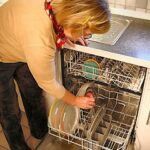Loading the dishwasher can sometimes feel like part art and part science. If you are tired of dealing with dishes coming out of the dishwasher with half of last night’s dinner stuck on them, you’ve come to the right place.
To get the most out of your dishwasher and have those gunky dishes come out sparkling clean, follow these tips and tricks to discover the art of loading the dishwasher (yes, it’s an art) and optimizing the performance of your machine.
Loading the Dishwasher 101
As you know, loading the dishwasher can be a tricky little task. Stuck on food is annoying, wastes time and effort, and also can be a health hazard.
So let’s start with the basics of loading the dishwasher correctly.
The most important thing to remember when loading the dishwasher is to ensure that each item is placed correctly. This includes having all the dishes face the same direction and making sure none are blocking the spray arms. Also, try to avoid overcrowding the dishwasher, as this can cause the water to not reach the intended target (it would be like bringing an umbrella into the shower with you!)
Preparing to Load the Dishwasher
Before you begin loading the dishwasher, take a minute to prepare. A great idea is to pre-wash only the dirtiest of dishes.
You can separate the dishes into two categories: lightly dirty and really dirty. In many cases, the lightly dirty dishes won’t even need a pre-wash, as studies show that most detergents are designed to interact with food enzymes to do some of that work for you.
So now you can focus your time and attention on the really gunky pile. These dishes need a pre-wash before going in the dishwasher so they can have a fighting chance coming out clean and sparkling. While enzymes are a good thing, there can be too much of a good thing (unless we’re talking about ice cream, which is a whole other post!)
Also, remove stuck-on food or debris from the dishes before loading them in the dishwasher. This step will help ensure that your dishes come out clean and debris-free. Even if the sticky food comes unstuck, the food particles can easily travel to nearby dishes, which is never a pleasant surprise.
So, What Goes Where in the Dishwasher?
When loading the dishwasher, certain items should go in certain places. For example, dirty plates, bowls and more oversized items should be placed on the bottom rack, with the dirtiest side facing toward the spray arms. Place cups, glasses and more delicate items on the top rack, dirty side down. If cups and glasses face upward, they will catch and hold water, as well as all the debris you may have missed from the previous tip!
Make sure the spray arms can reach all sides of dishes, cups, bowls, etc. If the water can reach them, there is a much better chance they will come out clean. And again, overcrowding the dishwasher can lead to improper cleaning, so avoid filling every inch of the rack spaces.
Related: 4 Things You Should Be Doing to Keep Your Home Appliances Running Smoothly
Soap and Cycle
Once the dishes are placed in the dishwasher, add the detergent and any other cleaning products desired, such as a rinse agent. Follow product label instructions and make a note to use the recommended amount.
You are ready to close the door tightly and lock it (if necessary). Choose the correct cycle for the dishes you are washing.
Once the cycle has finished, you’re ready to open the door, let cool and have someone else unload the dishwasher. You have worked hard enough!
What NOT to Put in the Dishwasher
While the dishwasher is designed to clean dishes, certain items should not and often cannot be cleaned there. These items include wooden utensils, non-dishwasher-safe plastics, cast iron cookware, fine China, sharp knives and some food storage containers. Also, never place meltable items such as aluminum foil, wax paper, and plastic wrap in the dishwasher, as they can clog the spray arms.
Optimizing Dishwasher Performance
Now that you know the proper way to load the dishwasher, you can use a few tips to optimize performance. For example, avoid using too much detergent, as this can cause over-sudsing, not allowing those enzymes to work correctly.
Also, while you don’t want to overcrowd the dishwasher, it will run more efficiently when full.
Common Dishwasher Issues (Dishhues?)
Two other common dishwasher problems are white film or lingering odor left on dishes.
The white film is often caused by hard water and can be prevented by using a water-softening agent. And if your dishes come out of the dishwasher with a funny smell, check the filter and clean if necessary.
In Conclusion
While loading the dishwasher correctly can seem tricky, following these tips will make the process faster. Remember:
1. Separate the extremely dirty dishes from the lightly dirty ones
2. Remove any food or debris
3. Place all items correctly in the dishwasher
4. Avoid overcrowding the dishwasher
5. Use the recommended amount of detergent
6. Choose the correct cycle
Still Need Help?
If your dishwasher is giving you problems and you think you may need professional dishwasher repair, Reliable Appliance Repair is here to help. Give us a call today to schedule your service appointment.





